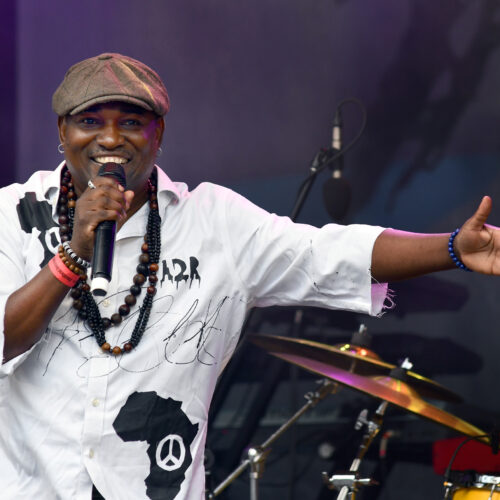Highly anticipated, the biopic of the mythical Bob Marley is analyzed here by our colleague Richard Lafrance, unquestionably one of Quebec’s leading specialists in Jamaican music. In Canada, Bob Marley One Love opens in theaters on Valentine’s Day, and PAN M 360 brings you the most comprehensive online review of it in this territory… and more!
On November 2, 1979, I went to the Montreal Forum to attend one of the most memorable shows of my young life: Bob Marley and The Wailers were there as part of the Survival tour. What a strange feeling, then, to find myself at the same venue 45 years later (renamed the Pepsi Forum, later Cinéma Cineplex Forum) for a screening of the biopic Bob Marley One Love. The film, pays tribute to the Rasta icon and beautifully presents him to the most recent generations.
Tribal warfare in Kingston
The script takes us back to Jamaica during the 1976-80 period, with Marley at the height of his international fame, as he agrees to perform for his local audience as part of the Smile Jamaica concert, proposed by Michael Manley, then Jamaica’s prime minister, at the height of a tribal and urban political war.
A few days later, perceived as being much closer to Michael Manley’s socialist-leaning People National Party than to Eddie Seaga’s pro-American Jamaican Labour Party, the singer was the victim of an armed attack at his Hope Road home. He was shot twice, his wife Rita was hit in the head (without any serious injury) and his manager Don Taylor was rushed to Florida for treatment after being hit by 6 bullets.
On a last-minute whim, Bob and Rita, still bloodied and in shock from the attack, decide to take to the stage with the musicians present who are brave enough to accompany them, and give one of the two defining Jamaican performances of their careers.
The second being, of course, the now-legendary One Love Peace Concert, during which Bob literally forced the two political opponents to shake hands on stage, in front of a Jamaica devastated by gun violence. The film ends right on the real scenes of this 1978 event.
To enhance the film’s biographical content, several flashbacks with two other younger Bobs – one around the age of 10 and the other, superbly played by young American actor Quadajay Henriques (Sean Paul’s cousin) around the age of 20 – expose crucial moments in his life and career.
The best examples are the Wailers’ audition, with intimidating producer Coxson Dodd and the hilarious Lee ” Scratch ” Perry at Studio One, the ” Jamaican Motown “, or the Groundation, a Rasta gathering on the beach, where Rita introduces Bob to Mortimer Planno, who will become his Rasta spiritual guide.
Since 1972 and the release of the cult film The Harder They Come starring Jimmy Cliff, no other film production has left such a lasting impression on the Jamaican (and international) imagination as this one.
In our actual context, Paramount’s people understood that Jamaica’s contribution would be essential to the project : more than 400 actors and technicians, in addition to 1,800 Jamaican extras were used for this 25-day shooting project, specifically in Trench Town, the Kingston ghetto where Bob grew up and at Kingston’s National Stadium, venue of the One Love Peace Concert.
The costumes are exact replicas of the wardrobe worn by Bob and his cohorts; the dialogue and dialect are natural and fluid, very much based on the actual events, apart from a few liberties taken in the script.
Kingsley Ben-Adir et Lashana Lynch, Oscarisables ?
Obviously, the greatest feat of this Brad Pitt-financed film, produced by Rita, Cedella and Ziggy Marley and directed by Reinaldo Marcus Green, concerns Kingsley Ben-Adir’s transformation into a veritable Kingstonian ” yardie “! The Williams, Joe Bell, Monsters and Men method, in fact.
Physical resemblance being the only obvious starting point (and yes, his “artificial” dreadlocks are totally believable!), the 38-year-old British actor had to learn to play the guitar, sing, dance and, above all, speak a credible, fluent patois… in his voice and with the intonations particular to Tuff Gong. Ben-Adir is said to have had some 50 interviews phonetically translated, and then received linguistic support.
Which raises the crucial question: Ziggy Marley claimed that none of his 7 sons and 10 grandsons, nor any Jamaican actor, could have played the role of Bob, for the purposes of the film, at around the age of 36. One assumes that the gem was long and hard to find, but rather on the UK side.
Kingsley Ben-Adir seems credible in every way. At live shows, Bob’s real voice can be heard on remixed soundtracks, giving the well-known songs a more contemporary sound. But for acoustic performances, it’s really the actor who sings. This gives the impression that he generally makes his character a little more playful than melancholy, despite all the vulnerability and insecurity expressed at other times.
For her part, Lashana Lynch, the British actress who was the first woman to play James Bond in No Time to Die (2021), plays with finesse and aplomb the matriarch of the Marley clan and backing vocalist for the I-Threes, the vocal trio that accompanied the Wailers on all their international tours, for which she put a serious solo career on hold.
Sons and daughters of…
Another Jamaican factor worthy of note is that several of the film’s actors and singers already have musical careers: singers Naomi Cowan, daughter of Carlene Davis and Tommy Cowan (ex-tour manager of the Wailers), who plays Marcia Griffiths, and Sevana, taking on the role of Judy Mowatt. Abijah Livingston plays his father, Bunny Wailer, and Aston Barrett Junior takes on the role of his father, the renowned bassist Family Man Barrett, who died at 77 two weeks ago.
Never without controversy
Since the film is produced by the Marley clan itself, it’s not surprising that the Gong’s extramarital adventures, particularly that torrid love affair at the end of his life with Cindy Breakspeare, Miss World 1976 who produced Damian ” Junior Gong ” Marley, arguably one of his most talented children, goes by the wayside.
Marley’s greatest love songs, Turn Your Lights Down Low and Waiting In Vain were inspired by the beauty queen. Despite all his misdeeds, Bob remained married to Rita until his death. In his 36 years of life, Bob Marley is said to have had over 15 children: 11 officially with 7 different mothers, 5 with Rita, 2 of whom were adopted.
One of the film’s most memorable scenes takes place in Paris, where Rita reminds her jealous husband that she must raise all his children – including those of his other mistresses – while being his backup singer and touring the world.
My downs
The (invented) scene in which Bob’s assailant appears to him (in a dream?) to beg his forgiveness, a completely superfluous scene and very far from the truth of what happened to the gunman in question.
The metaphorical scenes of young Bob escaping from a burning forest, accompanied by his biological white father whom he has only seen twice in his life, or his spiritual father, the one to whom he has dedicated his existence, Emperor Haile Selassie 1st, Jah Rastafari!
All in all?
Expectations were obviously very high for this film, and… despite the reservations expressed here, Ziggy Marley and those close to him rose to the challenge in fine style.
























